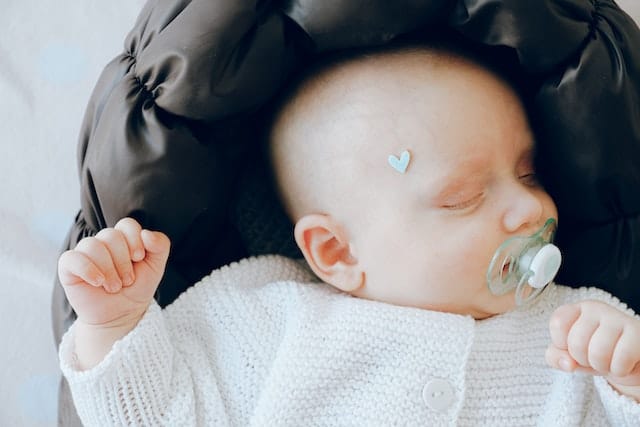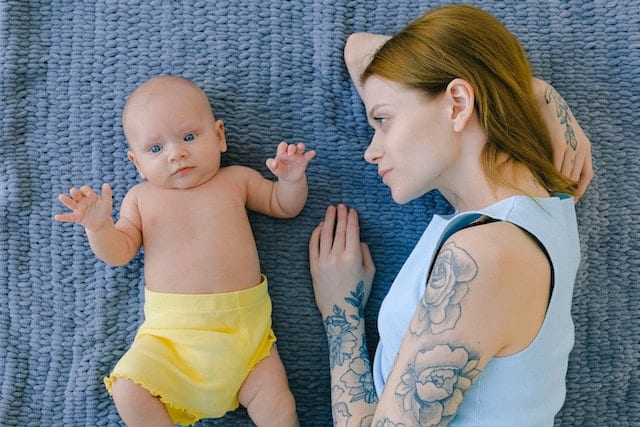Babies are known for their adorable sleeping positions, but one of the most common is when they sleep with their arms up. This phenomenon has puzzled many parents, who wonder why their little ones prefer this position.
In this article, we will explore the reasons why babies sleep with their arms up and what it means for their development.
Understanding the Moro reflex is key to understanding why babies sleep with their arms up. This reflex is an involuntary response that occurs when a baby feels like they are falling or losing support.
The reflex causes the baby to throw their arms up and outwards, which can startle them awake. However, some babies find comfort in this position and continue to sleep with their arms up.
Different baby sleeping positions can also play a role in why babies sleep with their arms up. Some babies prefer to sleep on their stomachs or sides, which can make it difficult to keep their arms tucked in.
Additionally, the role of comfort and environment cannot be underestimated, as babies may find it easier to sleep with their arms up in a certain type of bedding or in a particular room temperature.
Key Takeaways
- Babies sleep with their arms up due to the Moro reflex, which can startle them awake but also provide comfort.
- Different sleeping positions and environmental factors can also influence a baby’s preference for sleeping with their arms up.
- Swaddling can be a helpful technique for keeping a baby’s arms tucked in, but it is important to follow safety guidelines and consult a pediatrician if needed.
The Phenomenon of Babies Sleeping with Their Arms Up

It is a common sight to see babies sleeping with their arms up in the air. This phenomenon is referred to as the “startle reflex” or the “Moro reflex.” The startle reflex is a natural reflex that occurs in babies and is a way for them to protect themselves from falling.
When a baby is startled, they will throw their arms up in the air and then bring them back down to their sides. This reflex is usually seen in babies up to three or four months old. After this age, the reflex usually disappears.
There are a few theories as to why babies sleep with their arms up. One theory is that it is a way for them to regulate their body temperature. By sleeping with their arms up, they are able to cool down their body temperature and prevent overheating.
Another theory is that it is a way for them to feel secure. When a baby is sleeping with their arms up, they are in a vulnerable position. However, by having their arms up, they are able to protect themselves from falling or feeling unsupported.
In conclusion, the phenomenon of babies sleeping with their arms up is a natural reflex that occurs in most babies up to three or four months old. It is a way for them to protect themselves from falling and to regulate their body temperature.
Understanding the Moro Reflex
Babies are known for their adorable and sometimes quirky sleeping positions. One of the most common positions is sleeping with their arms up. This position is often associated with the Moro reflex, also known as the startle reflex.
The Moro reflex is a natural reflex that is present in newborn infants. It is a response to a sudden change in position or movement, such as being startled by a loud noise or sudden movement. When a baby experiences this reflex, they will typically throw their arms out to the side and then bring them back in towards their body.
This reflex is thought to be a protective mechanism that helps babies avoid danger. It is a sign that their nervous system is functioning properly and responding appropriately to stimuli.
The Moro reflex typically disappears around 3-6 months of age as the nervous system matures. However, some babies may continue to exhibit this reflex beyond this age.
In summary, the Moro reflex is a natural reflex present in newborns that is a response to sudden changes in position or movement. It is a sign that their nervous system is functioning properly and responding appropriately to stimuli.
Different Baby Sleeping Positions

Babies can sleep in various positions, and each one has its benefits. Here are some of the most common sleeping positions that babies prefer:
- Back sleeping: This is the safest position for babies to sleep. It helps reduce the risk of Sudden Infant Death Syndrome (SIDS). When babies sleep on their backs, they can breathe more easily, and their airways are less likely to be blocked.
- Side sleeping: Some babies prefer to sleep on their sides. This position is also safe for babies, but it’s essential to ensure that they don’t roll onto their stomachs during sleep. Side sleeping can also help reduce the risk of SIDS.
- Stomach sleeping: This position is not recommended for babies, as it increases the risk of SIDS. When babies sleep on their stomachs, their airways can become blocked, and they may have trouble breathing.
- Arms up sleeping: Many babies prefer to sleep with their arms up. This position is comfortable for them, and it allows them to move their arms freely during sleep. It’s also believed that this position helps babies regulate their body temperature.
- Fetal position sleeping: Some babies prefer to sleep in the fetal position, with their knees bent and their arms curled up. This position is comfortable for them and can help them feel secure.
It’s essential to remember that every baby is different and may have a preferred sleeping position. Parents should observe their baby’s sleeping habits and choose a position that is safe and comfortable for them.
The Role of Comfort and Environment
Babies sleep with their arms up for various reasons, and one of the most common is comfort. When infants are in the womb, they are in a curled-up position with their arms close to their body. This position provides comfort and security, and babies may continue to prefer it after birth.
The environment in which a baby sleeps can also play a role in why they sleep with their arms up. If a baby is swaddled, they are more likely to sleep with their arms up because the swaddling mimics the feeling of being in the womb.
Additionally, if a baby is sleeping on a firm surface, they may feel more secure with their arms up, as it helps them maintain their balance.
Body temperature can also be a factor in why babies sleep with their arms up. When a baby is too warm, they may naturally raise their arms to cool down. Similarly, if they are too cold, they may raise their arms to try and warm themselves up.
Overall, the role of comfort and environment in why babies sleep with their arms up is complex and multifaceted. By understanding these factors, parents and caregivers can create a safe and comfortable sleep environment for their little ones.
Swaddling and Its Variations
Swaddling is a common practice of wrapping infants snugly in a blanket to provide a sense of security and comfort, mimicking the feeling of being in the womb. Swaddling with arms up or down is a personal preference, and parents should choose the method that works best for their baby.
Swaddling with arms up is also known as the “hands-over-heart” position, where the baby’s arms are positioned above their chest. This position allows the baby to self-soothe by sucking on their hands or fingers. It can also prevent the startle reflex, which can disrupt sleep.
Arms-down swaddling, on the other hand, involves wrapping the baby’s arms tightly against their body. This method is recommended for babies who tend to move around a lot during sleep, as it can prevent them from accidentally waking themselves up.
There are also variations of swaddling, such as the “double swaddle” or “swaddle sack.” The double swaddle involves wrapping the baby in two blankets, one for the arms and one for the body, to provide extra security.
Swaddle sacks are pre-made sacks with a built-in swaddle, making it easier for parents who struggle with traditional swaddling techniques.
It is important to note that swaddling should only be done for the first few months of a baby’s life, as they begin to roll over and become more mobile. Additionally, swaddling should always be done correctly to avoid any potential risks, such as overheating or hip dysplasia.
Overall, swaddling can be a helpful tool for parents to soothe their newborns and promote better sleep. However, it is important to understand the different variations and techniques to ensure the safety and comfort of the baby.
Safety Guidelines for Baby Sleep

When it comes to baby sleep, safety is always a top priority. Here are some guidelines to follow to ensure your baby sleeps safely with arms up:
Safe Sleep Guidelines
The American Academy of Pediatrics (AAP) recommends the following safe sleep guidelines for infants:
- Always place your baby on their back to sleep, for naps and at night.
- Use a firm and flat sleep surface, such as a crib or bassinet, covered with a fitted sheet.
- Keep soft objects, loose bedding, and anything else that could increase the risk of suffocation out of the crib.
- Avoid overheating your baby during sleep. Dress them in lightweight clothing and keep the room at a comfortable temperature.
Sudden Infant Death Syndrome (SIDS)
Sudden Infant Death Syndrome (SIDS) is a tragic and devastating event that can occur during sleep. While the exact cause of SIDS is unknown, there are steps you can take to reduce the risk:
- Always place your baby on their back to sleep.
- Use a firm and flat sleep surface, such as a crib or bassinet, covered with a fitted sheet.
- Keep soft objects, loose bedding, and anything else that could increase the risk of suffocation out of the crib.
- Avoid overheating your baby during sleep. Dress them in lightweight clothing and keep the room at a comfortable temperature.
- Do not smoke during pregnancy or allow anyone to smoke around your baby.
- Breastfeed your baby, if possible.
Conclusion
By following these safety guidelines, you can help ensure that your baby sleeps safely with arms up. Remember to always place your baby on their back to sleep, use a firm and flat sleep surface, and keep soft objects and loose bedding out of the crib.
If you have any concerns about your baby’s sleep habits or safety, talk to your pediatrician.
Sleep Routines and Habits
Establishing a consistent sleep routine is important for babies to develop healthy sleep habits. A bedtime routine can help signal to a baby that it is time to sleep and can include activities such as a bath, reading a story, or singing a lullaby.
A naptime routine can also be helpful and may include a shorter version of the bedtime routine.
In addition to routines, self-soothing techniques can help babies fall asleep and stay asleep. Some babies may prefer to sleep with their arms up as it can provide a sense of comfort and security.
Swaddling can also be helpful for younger babies who have not yet developed the ability to self-soothe.
It is important to note that each baby is unique and may have different preferences when it comes to sleep. It is important to observe and respond to a baby’s individual needs and adjust routines and habits accordingly.
Creating a safe and comfortable sleep environment can also help promote healthy sleep habits.
When to Consult a Pediatrician
While it is common for babies to sleep with their arms up, there are instances where it may be a cause for concern. If your baby is consistently waking up crying or appears to be in discomfort, it may be a sign of an underlying issue.
One possible cause of discomfort could be reflux. Reflux occurs when the contents of the stomach flow back into the esophagus, causing irritation and discomfort. If your baby is experiencing reflux, they may be more likely to sleep with their arms up as it can help alleviate the discomfort.
However, if you suspect your baby has reflux, it is important to consult with a pediatrician to rule out any other potential issues and to develop a treatment plan.
If your baby is older and has transitioned to a toddler bed, sleeping with their arms up could be a sign of an underlying sleep issue. If your toddler is consistently waking up throughout the night or appears to be restless, it may be a sign of a sleep disorder.
Consulting with a pediatrician can help identify any potential sleep issues and develop a plan for treatment.
In general, if you are concerned about your baby’s sleeping habits, it is always best to consult with a pediatrician. They can help identify any underlying issues and provide guidance on how to address them. By working with a pediatrician, you can ensure that your baby is getting the best possible care and is able to sleep comfortably and soundly.
Related: Baby Raising Arms Above Head
Frequently Asked Questions
Do babies sleep better with their arms up?
It depends on the baby. Some babies may find it more comfortable to sleep with their arms up, while others may prefer to sleep with their arms down. There is no one-size-fits-all answer to this question, as each baby is unique and has their own preferences when it comes to sleep.
Why do some babies sleep with their arms up?
Babies may sleep with their arms up for a variety of reasons. One possible explanation is that it allows them to feel more secure and comfortable, as it mimics the position they were in while in the womb.
Additionally, some babies may simply find it more comfortable to sleep in this position.
Is it safe for babies to sleep with their arms up?
Yes, it is generally safe for babies to sleep with their arms up. However, it is important to ensure that they are sleeping on their back and that they are not swaddled too tightly, as this can increase the risk of Sudden Infant Death Syndrome (SIDS).
Can sleeping with arms up affect baby’s development?
There is no evidence to suggest that sleeping with arms up can affect a baby’s development. However, it is important to ensure that they are sleeping in a safe and comfortable position to promote healthy growth and development.
What are the benefits of babies sleeping with their arms up?
Sleeping with arms up can help babies feel more secure and comfortable, which can promote better sleep. Additionally, it can help them develop strong neck and shoulder muscles, as they will need to support the weight of their arms in this position.
How can I help my baby sleep comfortably with arms up?
If your baby prefers to sleep with their arms up, there are a few things you can do to help them sleep comfortably. One option is to use a sleep sack or swaddle that allows their arms to be free.
Additionally, you can try placing a rolled-up blanket or towel under their armpits to provide additional support and comfort.

Iesha is a loving mother of 2 beautiful children. She’s an active parent who enjoys indoor and outdoor adventures with her family. Her mission is to share practical and realistic parenting advice to help the parenting community becoming stronger.
